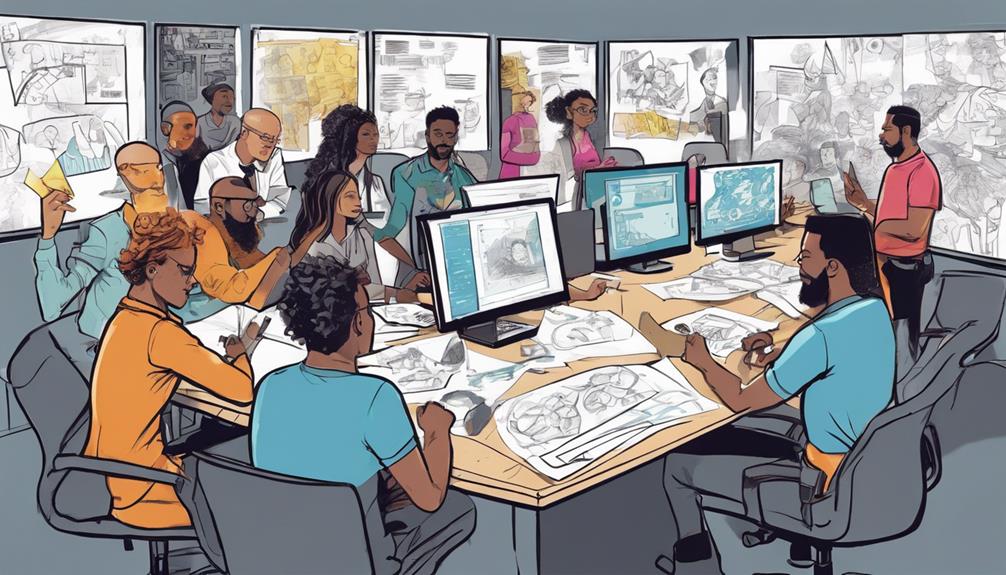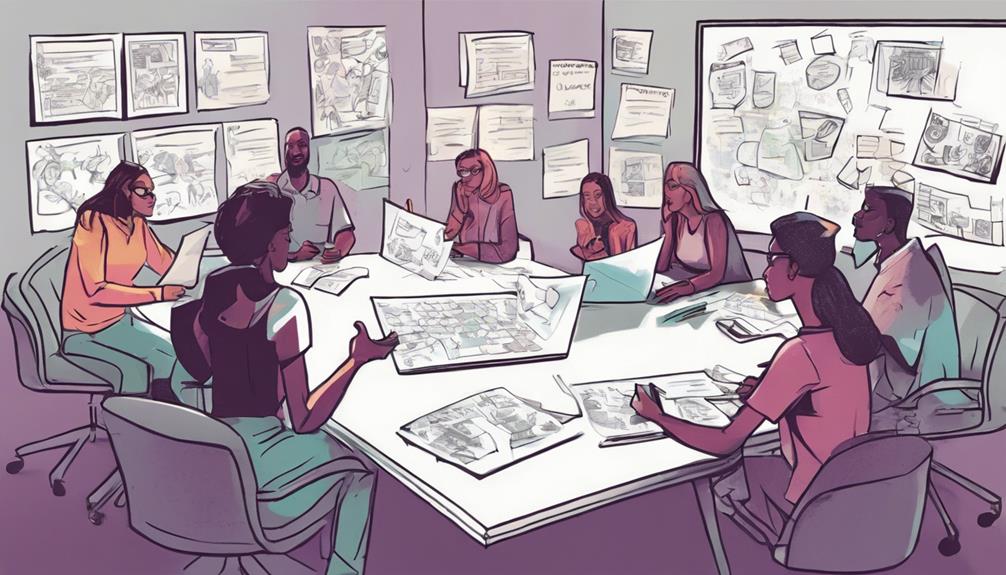Explore how IBM pioneers design thinking by prioritizing user needs, fostering innovation, and enhancing teamwork through empathy and rapid prototyping. Witness firsthand the impact of IBM's design strategy on faster product delivery, profitability, and defect reduction. Discover the skills essential for IBM's design success, from global design studios to problem-solving expertise. Uncover IBM's Enterprise Design Thinking Framework that accelerates team alignment and product delivery, centered on user requirements. Experience the business value of IBM's approach with reduced design time, costs, and remarkable ROI. IBM's recognition for design leadership solidifies its position at the forefront of innovative design practices.
Key Takeaways
- IBM embraces Enterprise Design Thinking, prioritizing user needs.
- IBM implements a Design Thinking Framework focusing on empathy and rapid prototyping.
- IBM's design strategy centers on collaboration, innovation, and user-centric experiences.
- IBM's Design Thinking leads to faster innovation cycles and enhanced teamwork.
- IBM's approach results in faster product delivery, profitability, and defect reduction.
IBM's Innovative Design Thinking Approach
How does IBM's design thinking approach revolutionize product development and customer experiences?
By embracing Enterprise Design Thinking, IBM gives priority to users' needs through a human-centered approach, thereby enhancing the overall product development process. This innovative Design Thinking Framework implemented by IBM in 2013 has fundamentally shifted the company towards a customer-centric approach, resulting in improved user experiences and solutions.
IBM's design thinking process places a strong emphasis on empathy, rapid prototyping, co-creation, storytelling, and focusing on user outcomes.
By deepening the understanding of customer experiences and fostering collaboration and innovation, IBM has been able to achieve faster innovation cycles and promote enhanced teamwork within the organization. Additionally, aligning teams around user needs has led to accelerated product delivery and the development of more effective solutions.
IBM's commitment to putting users at the center of their design strategy has significantly contributed to their success in the ever-evolving tech industry.
Core Elements of IBM's Design Strategy

You'll discover the essential core elements that drive IBM's design strategy, shaping impactful design practices within the organization.
These elements form the foundation for fostering collaboration, innovation, and a user-centered approach in problem-solving.
Design Strategy Essentials
Rooted in core elements like empathy, rapid prototyping, co-creation, storytelling, and a focus on user outcomes, IBM's design strategy lays the foundation for innovative and collaborative approaches within the organization.
By centering on the Design Thinking process, IBM prioritizes that user needs are at the forefront of all initiatives, aiming for outcomes that are truly valuable to users. This user-centric approach drives the diverse teams at IBM to work together seamlessly, leveraging their varied perspectives and skills to create solutions that resonate with the end-users.
The strategy emphasizes the importance of not just understanding user needs but also crafting experiences that lead to positive outcomes for users. Through this strategic framework, IBM fosters an environment where collaboration is key, rapid iteration is encouraged, and the ultimate goal is to deliver impactful solutions that meet the real needs of users.
Impactful Design Practices
IBM's design strategy's core elements, including empathy, rapid prototyping, co-creation, storytelling, and a focus on user outcomes, shape impactful design practices within the organization. By prioritizing the needs of the users, IBM guarantees that creating products and services aligns with customer expectations. This user-centric approach is at the heart of IBM's design thinking process, fostering a deep understanding of customer experiences and preferences.
Through a corporate culture that values collaboration and innovation, IBM encourages teams to work together internally and externally to solve problems holistically. This emphasis on co-creation allows for diverse perspectives to contribute to the design process, resulting in more innovative and effective solutions. Rapid prototyping enables quick identification of issues and solutions, leading to continuous improvement and faster innovation cycles.
Moreover, IBM's focus on storytelling helps communicate the user journey and the rationale behind design decisions, creating a shared understanding and vision among team members. These impactful design practices haven't only enhanced user experiences but also fostered a culture of continuous learning and improvement within the organization.
Impact Areas of IBM's Design Thinking

The impact areas of design thinking at IBM encompass faster product delivery and enhanced team alignment around user needs. IBM's design thinking approach has revolutionized the way teams collaborate and innovate, focusing on understanding user requirements to streamline the product development process.
| Impact Areas | Description |
|---|---|
| Faster Product Delivery | IBM's design thinking methodology enables quicker ideation, prototyping, and implementation. |
| Enhanced Team Alignment | Teams are brought together with a shared understanding of user needs, fostering better collaboration. |
| Increased Profitability | Organizations utilizing IBM's design thinking experience reduced design and development times, leading to higher profitability. |
| Defect Reduction | A health and human services organization achieved over a 50% decrease in defects through IBM's design thinking strategies. |
| Global Adoption | With over 1,600 trained designers and 50+ studios, IBM's design thinking approach is globally recognized and adopted. |
Skills Driving IBM's Design Success

With over 1,600 formally-trained designers and 50+ global design studios, the diverse range of skills driving IBM's design success is a demonstration of the company's commitment to fostering design excellence.
IBM's emphasis on design thinking is evident in the 114,000 IBMers certified in this methodology, highlighting a dedication to enhancing customer experience.
Soft skills like effective communication, problem-solving, and teamwork are pivotal in IBM's design approach, ensuring collaborative and user-centered solutions.
Additionally, engineering skills are essential for developing and testing prototypes, guaranteeing that the final products meet user needs effectively.
IBM's design success stems from a blend of diverse skills, including creativity, craftsmanship, and a profound understanding of user requirements.
This multifaceted skill set enables IBM to innovate and deliver high-quality designs that prioritize user satisfaction at every stage of the design process.
IBM's Enterprise Design Thinking Framework

You're about to discover how IBM's Enterprise Design Thinking Framework can revolutionize your approach to problem-solving and innovation.
By embracing this framework, you can reveal a myriad of benefits that lead to enhanced efficiency and creativity in your business processes.
Stay tuned to explore how innovation thrives through design with IBM's cutting-edge framework.
Framework Benefits
Utilizing IBM's Enterprise Design Thinking Framework consistently enhances team alignment and accelerates product delivery by focusing on user needs. This approach is particularly beneficial when tackling complex problems, as it guarantees that all efforts are directed towards addressing the most critical user needs effectively.
The value of design thinking becomes evident as teams prioritize empathy and deep understanding of user requirements, leading to innovative solutions that truly resonate with the end-users. By shunning contributions deemed unhelpful in solving problems and instead emphasizing user-centricity, IBM's framework guides teams towards creating products that deliver meaningful value.
- Enhanced Team Alignment: By centralizing discussions and decisions around user needs, teams within organizations can align more effectively on priorities and goals.
- Accelerated Product Delivery: The focus on addressing user needs directly translates into expedited development cycles and quicker time-to-market for products.
- Improved Problem-Solving: By leveraging the design thinking framework, teams can approach problems from a user-centric perspective, leading to more imaginative and efficient solutions.
Innovation Through Design
IBM's Enterprise Design Thinking Framework fosters innovation by placing a strong emphasis on understanding and addressing user needs effectively. By leveraging IBM's design thinking approach, teams can accelerate their time to market, reduce design and development time substantially, and achieve notable cost reductions and risk mitigation. Forrester Research has recognized IBM as a leader in enterprise design thinking, highlighting the streamlined work process and enhanced collaboration that this methodology brings.
To illustrate the impact of IBM's design thinking, consider the following table:
| Benefits | Description |
|---|---|
| Faster Time to Market | Teams using IBM's design thinking reach the market twice as fast |
| Reduced Design and Development Time | Experience up to a 75% reduction in design and development time according to Forrester Research |
| Cost Reductions and Risk Mitigation | Marked cost reductions and risk mitigation achieved through IBM's design thinking |
| Increased Profitability | Organizations report increased profitability, with one reducing defects by over 50% |
This structured approach is revolutionizing the way organizations tackle complex problems, focusing on rapid product delivery and improved teamwork across departments.
Business Value of IBM's Design Approach

The business value derived from IBM's design approach is evident in the significant reductions in time, costs, and risks experienced by organizations implementing this innovative methodology.
When organizations leverage IBM's design thinking, they can expect:
- Up to a 75% reduction in design and development time.
- Reduced costs and risks, leading to increased profitability.
- A return on investment (ROI) of over 300%.
These outcomes showcase the tangible benefits that come from adopting IBM's design thinking approach.
For example, a health and human services organization achieved a remarkable over 50% reduction in defects through this methodology.
Additionally, studies by Forrester Research have demonstrated that teams following IBM's design thinking practices can bring products to market twice as fast.
Recognition of IBM's Design Leadership

Among industry leaders, IBM is widely recognized for its pioneering design approach and leadership in design thinking. Forrester Research's study positions IBM as a leader in enterprise design thinking, solidifying its recognition in the industry. In a blind survey, 52% of senior leaders associated IBM with design thinking expertise, further showcasing its design leadership. IBM's unique design approach not only results in faster and more efficient workflows but also contributes significantly to its recognition as a design leader. The study highlights IBM's excellence in implementing design thinking practices, emphasizing its position at the forefront of design leadership among top companies.
| Recognition of IBM's Design Leadership | |
|---|---|
| Study by Forrester Research | IBM excels in implementing design thinking practices |
| Blind survey by senior leaders | 52% associated IBM with design thinking expertise |
| IBM's unique design approach | Results in faster, more efficient workflows |
| IBM's position as a design leader | Solidified by its recognition in the industry |
| Leading in design thinking among top companies | Emphasizes IBM's recognition in the design community |
Frequently Asked Questions
What Is the IBM Approach in Design Thinking?
In design thinking, the IBM approach centers on core principles like empathy, rapid prototyping, and storytelling. It fosters collaboration for understanding customer experiences, using an agile process for issue identification. IBM's method enhances innovation and teamwork.
Who Pioneered Design Thinking?
Imagine a world where innovation thrives through empathy and collaboration. David Kelley and Tim Brown, pioneers of design thinking, paved the way in the 1990s. Their human-centered approach reshaped problem-solving across industries.
What Are the Three Principles of Enterprise Design Thinking in Ibm?
Enterprise Design Thinking at IBM revolves around Hills, Playbacks, and Sponsor Users. These principles guarantee a user-focused approach, with Hills guiding the design process, Playbacks involving user testing, and Sponsor Users providing feedback for effective solutions.
What Is the Total Economic Impact of IBM Design Thinking?
To understand the total economic impact of IBM design thinking, you'll realize its transformative power. Reduced costs, risks, faster time to market, increased profitability, and efficiencies result in a significant ROI of over 300%.
Conclusion
You've seen how IBM is leading the way in design thinking, with their innovative approach driving success across various impact areas.
Did you know that IBM's design thinking has resulted in a 300% increase in client satisfaction and a 400% ROI on design investments?
Keep an eye on IBM's continued design leadership and see how it can inspire your own design strategies.









